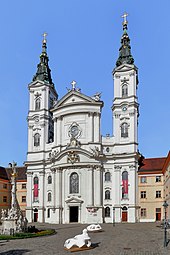Franz custom
Franz Sitte (born July 8, 1818 in Weißkirchen in Northern Bohemia, today Bílý Kostel nad Nisou ; † June 26, 1879 in Penzing (incorporated into Vienna since 1892)) was an Austrian builder, architect and father of Camillo Sitte .
Life
Franz Sitte was the youngest of nineteen siblings and became an orphan at the age of eight . Originally he should have pursued a teaching career and for this purpose attended the grammar school in Reichenberg (today's Liberec ). Through the acquaintance of two master builder's sons, he decided to do an apprenticeship with a master builder (1835–37) and then studied architecture at the Vienna Academy of Fine Arts with Pietro Nobile . Despite receiving an academic award and the assurance of a scholarship, he dropped out of this course after two years. From August 1840 to the beginning of 1841 he stayed in Munich. He financed his living as an architectural draftsman and construction manager, including from 1841 to 1842 in the architecture office of Franz Xaver Lössl . In Munich he met the Swiss architect Johann Georg Müller , the winner of the competition to build the Altlerchenfeld parish church in Vienna. Sitte was the first draftsman for the construction of this from 1848 and, after Müller's death, was his successor in the construction management of the "Rennaisance Church in Altlerchenfeld" a year later. In 1861 he was awarded the Golden Cross of Merit with the crown.
family
Sitte married Theresia Schabes († 1863), thirteen years his senior, in 1842. The only son from this connection was born in 1843 and was the famous architect and city planner Camillo Sitte . His grandson Heinrich Sitte became a professor of classical archeology at the University of Innsbruck .
Works


Extract from the architectural dictionary 1770-1945:
- 1848–1861: Altlerchenfelder parish church , Vienna 7th (initially construction management under Georg Müller, after his death responsible for the completion in particular for the details of the exterior)
- 1852–1854: Priesterhauskapelle Vienna, 3, Ungargasse 38 (not preserved)
- 1856–1858: Church in Jedenspeigen (extension and Marienkapelle), Lower Austria
- 1853–1858: Archbishop Milde's tomb, Katharinenkapelle, St. Stephen's Cathedral, Vienna 1st district
- 1856–1869: Maria Treu Piarist Church (facade and towers), Vienna 8th, Jodok-Fink-Platz
- 1860–1870: Catholic parish church, Bad Vöslau , Lower Austria
- 1862: former Piarist girls' school, Vienna 8, Lederergasse 8
- 1871–1874: Mechitaristenkirche , Vienna 7, Neustiftgasse 4 (renovation, with Camillo Sitte)
literature
- Constantin von Wurzbach : Sitte, Franz . In: Biographisches Lexikon des Kaiserthums Oesterreich . 35th part. Imperial-Royal Court and State Printing Office, Vienna 1877, p. 37 f. ( Digitized version ).
- E. Schmalhofer: Sitte, Franz. In: Austrian Biographical Lexicon 1815–1950 (ÖBL). Volume 12, Verlag der Österreichischen Akademie der Wissenschaften, Vienna 2001-2005, ISBN 3-7001-3580-7 , p. 310.
Web links
- Franz custom. In: Architects Lexicon Vienna 1770–1945. Published by the Architekturzentrum Wien . Vienna 2007.
- Literature by and about Franz Sitte in the catalog of the German National Library
- German biography: Sitte, Franz
Individual evidence
- ↑ Constantin von Wurzbach : Sitte, Franz . In: Biographisches Lexikon des Kaiserthums Oesterreich . 35th part. Imperial-Royal Court and State Printing Office, Vienna 1877, p. 37 f. ( Digitized version ).
- ↑ Rudolf Wurzer: Camillo Sitte - Life, Work and Position. Reprint d. 3rd edition 1901 and the original manuscript from 1889 - Urban development according to its artistic principles. In: Series d. Inst. F. Urban planning, spatial planning, etc. Spatial planning. Vienna University of Technology, Vol. 19 1972 ed. R. Wurzer. Foreword p. IX. Springer Verlag Vienna ISBN 3-211-81 118-4
- ^ E. Schmalhofer: Sitte, Franz. In: Austrian Biographical Lexicon 1815-1950 (ÖBL). Volume 12, Verlag der Österreichischen Akademie der Wissenschaften, Vienna 2001-2005, ISBN 3-7001-3580-7 , p. 310.
- ↑ a b Franz Sitte. In: Architects Lexicon Vienna 1770–1945. Published by the Architekturzentrum Wien . Vienna 2007.
| personal data | |
|---|---|
| SURNAME | Custom, Franz |
| BRIEF DESCRIPTION | Austrian builder and architect |
| DATE OF BIRTH | July 8, 1818 |
| PLACE OF BIRTH | Weißkirchen in Bohemia, today Bílý Kostel nad Nisou |
| DATE OF DEATH | June 26, 1879 |
| Place of death | Penzing |